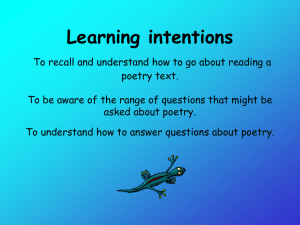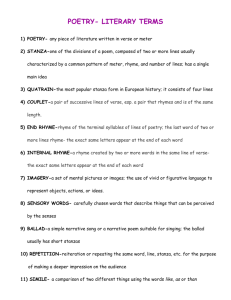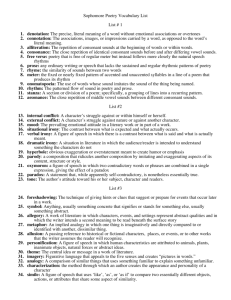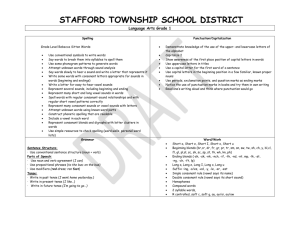Connected speech - elt
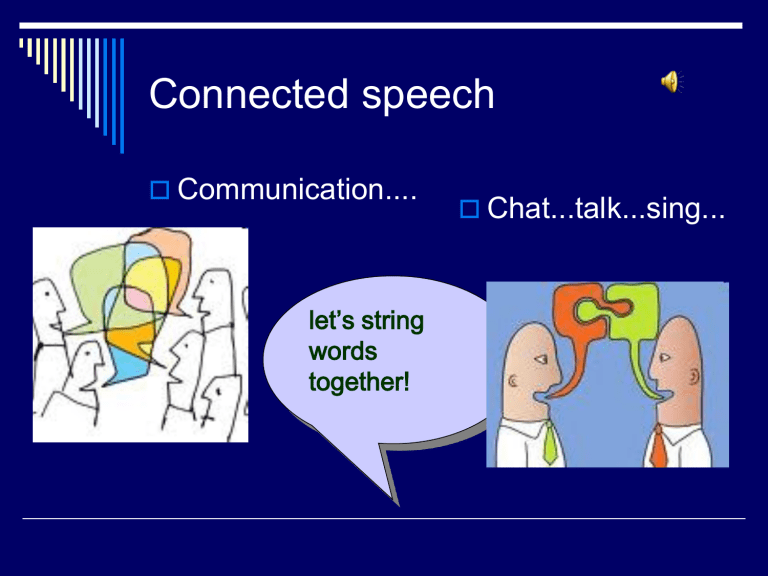
Connected speech
Communication....
Chat...talk...sing...
let’s string words together!
What is connected speech?
Fluent speech flows with a rhythm and the words bump into each other.
To make speech flow smoothly the way we pronounce the end and beginning of some words can change depending on the sounds at the beginning and end of those words.
Features of connected speech
Linking sounds
Consonant to vowel linking – when the first word ends with a consonant sound and the second word begins with a vowel sound. E.g. Fried egg / a box oveggs / cupov tea /doyer? We change the sounds to make it flow!
Vowel to vowel linking –when the first word ends in a vowel and the next words begins with a vowel sound.
We add a ‘w’ or ‘y’ sound.E.g.’ go in’ / say it/do it/two eggs/ hiya! / cudyer?
Consonant to consonant linking – when the first word ends in a consonant and the next one begins with a consonant sound. We don’t hear both separately, we just hear one. E.g. We only hear one /t/ E.g. A bit tired
/lot to do
Features of connected speech
Disappearing sounds
In rapid speech the /t/ or the /g/ sound at the end of the word often disappears completely if there are consonant sounds either side. e.g. next week / can’t swim/ going for .
This also happens with the /d/ sound. e.g. sandwich – san(d)wich. Fish and chips – fish an chips/bread an cheese.
The /h/ sound is often deleted. E.g. You shouldn’t (h)ave told
(h)im/ We could (h)ave.
The unstressed schwa(ɘ) is often lost. E.g. t(o)night/ got t(o)ave.
Features of connected speech
Weak sounds
There are a large number of words in English which can have a ‘full’ form or a ‘weak’ form. This is because
English is a stress timed language, and in trying to make the intervals between stressed syllables equal, to give us rhythm, we tend to swallow non-essential words. Thus, we lose pronouns, conjunctions, prepositions, auxiliaries and articles. E.g.
And – a table ‘n chair
Can – She c/ɘ/n speak English
Of – A cup ov coffee
Have – Av you finished?
Should – You sh/ɘ/d av told me.
The verb ‘to be’ – I’m He’s
Features of connected speech
Changing Sounds
Listen to two words said individually, then listen to them in a sentence – Can you hear the difference?
Sometimes the sound at the end of the first word takes on the quality of the sound at the beginning of the second word. e.g.
She’s a good girl.
This is to do with the place in the mouth where we make the sounds. E.g. When we say /b/ or /p/ we can feel that both your lips are pressed together.
When we say /t/ or /d/ or /n/ we can feel that our tongue is touching above our top teeth.
When you say /k/ or /g/ or the –ng sound, we can feel the back of our tongue touching the roof of our mouth.
Examples:
Good girl – goog girl/goob boy
Ten pounds – tem pounds
Good mornin – goob mornin
Not quite – nok quite
So..
To sum up....
Connected speech consists of:
Linking sounds
Disappearing sounds
Weak sounds
Changing sounds
So let’s connect and chat!!!
Practice and patience!
Helpful websites to chat and practice!
www.bbclearningenglish.com
www.englishcentral.com
www.elllo.org/
www.cambridgeenglishonline.com/Phon etics_Focus/
Bibliography
Books
Underhill, A. (2005). Sound foundations. Oxford. Macmillan
Publishers Ltd.
Internet sites
Talk about English (July 2005). Retrieved 5 June 2010 from www.bbclearningenglish.com
Connected speech.(2006). Retrieved from www.eslsite.com/rd/Pronounciation/connected_speech.html
Learning English – I would like to buy a hamburger. Retrieved from www.youtube.com

